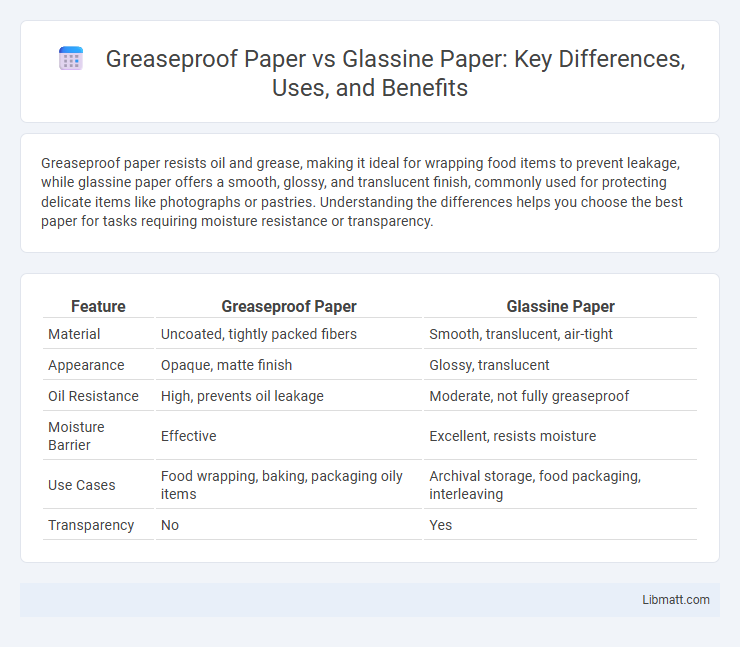Greaseproof paper resists oil and grease, making it ideal for wrapping food items to prevent leakage, while glassine paper offers a smooth, glossy, and translucent finish, commonly used for protecting delicate items like photographs or pastries. Understanding the differences helps you choose the best paper for tasks requiring moisture resistance or transparency.
Table of Comparison
| Feature | Greaseproof Paper | Glassine Paper |
|---|---|---|
| Material | Uncoated, tightly packed fibers | Smooth, translucent, air-tight |
| Appearance | Opaque, matte finish | Glossy, translucent |
| Oil Resistance | High, prevents oil leakage | Moderate, not fully greaseproof |
| Moisture Barrier | Effective | Excellent, resists moisture |
| Use Cases | Food wrapping, baking, packaging oily items | Archival storage, food packaging, interleaving |
| Transparency | No | Yes |
Introduction to Greaseproof and Glassine Paper
Greaseproof paper is a porous, treated paper designed to resist grease and oil penetration, making it ideal for food wrapping and baking applications. Glassine paper is a smooth, glossy, and translucent paper produced by supercalendering, offering excellent grease resistance and moisture barrier properties. Both papers serve in packaging and preservation but differ in texture, transparency, and impermeability levels.
Composition and Manufacturing Process
Greaseproof paper is made by refining wood pulp through a chemical or mechanical process to create a dense, low-porosity sheet that resists oil and grease penetration without added coatings. Glassine paper is produced by supercalendering, a process that compresses and smooths the fibers, resulting in a translucent, glossy surface with inherent grease resistance due to its dense fiber structure. Both papers rely on manipulating cellulose fibers, but greaseproof paper emphasizes chemical refining for oil resistance, whereas glassine achieves strength and grease resistance primarily through mechanical calendaring.
Key Differences in Appearance
Greaseproof paper has a matte finish with a slightly rough texture, making it opaque and ideal for blocking grease and moisture. Glassine paper, on the other hand, features a smooth, glossy, and translucent surface that offers a polished appearance while providing a moisture-resistant barrier. Your choice between the two will depend on whether you prioritize opacity and texture (greaseproof) or translucency and smoothness (glassine).
Oil and Grease Resistance Comparison
Greaseproof paper is specially treated to prevent oil and grease penetration, offering moderate resistance ideal for wrapping oily foods, while glassine paper features a smooth, glossy finish with superior oil and grease resistance due to its dense, compressed fibers. Glassine paper's high barrier properties make it more effective for packaging applications requiring enhanced protection against moisture and grease. Both papers serve food packaging but glassine surpasses greaseproof paper in preventing oil seepage and maintaining product integrity.
Common Uses of Greaseproof Paper
Greaseproof paper is widely used in food packaging to prevent grease and oil from soaking through, making it ideal for wrapping baked goods, sandwiches, and greasy foods. It is also employed as a liner for baking trays and cake tins due to its heat resistance and non-stick properties. Unlike glassine paper, which is often used for archival purposes and wrapping delicate items, greaseproof paper's main advantage lies in its ability to repel grease and moisture effectively during food storage and preparation.
Typical Applications of Glassine Paper
Glassine paper is commonly used in food packaging to provide a moisture-resistant and grease-resistant barrier, making it ideal for wrapping baked goods, candy, and sandwiches. It also serves in archival and art applications to protect photographs, documents, and artwork due to its smooth, non-stick surface that prevents smudging and sticking. Your choice of glassine paper supports preservation and protection in various commercial and personal uses.
Environmental Impact and Sustainability
Greaseproof paper is often biodegradable and compostable, made from uncoated cellulose fibers that allow it to break down naturally, reducing landfill waste and environmental pollution. Glassine paper, while also biodegradable, is produced through a supercalendering process that creates a dense, non-porous surface but may require more energy and chemical treatments, impacting its overall sustainability. Choosing greaseproof paper generally supports lower environmental impact due to its simpler manufacturing and easier recyclability compared to glassine paper's specialized processing.
Food Safety and Regulatory Considerations
Greaseproof paper, made from highly refined cellulose fibers, offers excellent oil and grease resistance, making it suitable for direct contact with food under strict food safety regulations such as FDA and EU standards. Glassine paper, characterized by its smooth, glossy surface and semi-transparency, is also food-safe but may require specific certification for use with fatty or oily foods to ensure compliance with migration limits and hygiene guidelines. Your choice between greaseproof and glassine paper should consider the regulatory certifications relevant to your food product to guarantee safety and compliance.
Cost and Availability
Greaseproof paper is generally more affordable and widely available due to its simpler manufacturing process and common use in food packaging. Glassine paper, known for its smooth, glossy finish and moisture resistance, tends to cost more and is less commonly stocked in general retail stores. If budget and easy access are priorities, greaseproof paper is often the better choice for your packaging needs.
Choosing the Right Paper for Your Needs
Greaseproof paper offers excellent resistance to oil and moisture, making it ideal for wrapping greasy foods or baking applications, while glassine paper provides a smooth, translucent barrier that repels grease but is less porous, perfect for packaging delicate items like baked goods or art supplies. Understanding the specific requirements of your project, such as moisture resistance, transparency, and durability, will help you determine which paper serves your purpose best. Choose your paper based on the balance between functionality and presentation to achieve optimal results.
Greaseproof paper vs glassine paper Infographic

 libmatt.com
libmatt.com